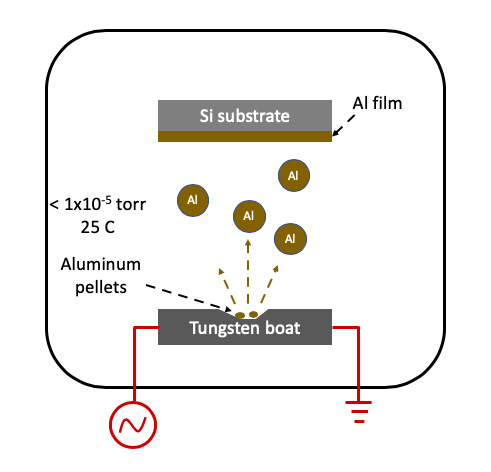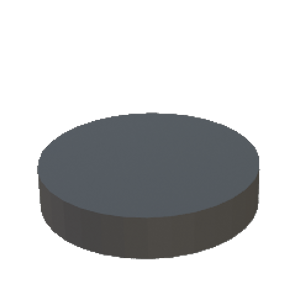Metal Deposition (Thermal)
Metal Deposition by Thermal evaporataion starts by heating the material of interest at a high enough temperature that creates a sufficient vapor pressure of material in vacuum. Typically, the material is used in small pellet form (e.g. 1mm size) and kept inside/top of boat (e.g. tungsten). The boat material is selected such that it has higher melting point and that does not form alloy with material of interest. High current is passed through boat to heat the boat/material (resistive heating) to desired temperature. The evaporated material is then deposited on substrate of intereste. High mean free path in vacuum ensures that most evaporated material is deposited on the substrate of interest.

Step-by-Step illustration of Metal Deposition Process:

STEP 1: Start with Si wafer (substrate)

STEP 2: Si wafer (substrate) with Aluminum thin film on top
The above process can be carried out in IMSE Facility. IMSE offers (Thermal Evaporator) to accomplish the task safely. Click the link to start the training process.
Thin film metrology
Estimating film deposition peformance (deposition rate, planar roughness, side wall roughness, etc.) is critical to fabricate device at micron scale in repeated manner. IMSE offers number of instruments (Profilometer, Optical Microscope, In-situ Quartz Crystal Microbalance (QCM) Sensor, SEM) to help in the quantitative measurements.
- Optical microscope can measure the critical dimension width (for patterned thin films)
- Profilometer can measure the thin film height as long as step edge is available. The simplest solution may be to cover part of planar surface with kapton tape during metal deposition. Instrument may also be used to estimate roughness of deposited films.
- In-situ QCM sensor can measure the thickness deposited on substrate in real-time. However, the sensor must be calibrated against another metrology (for example, Profilometer) before using for measurement.